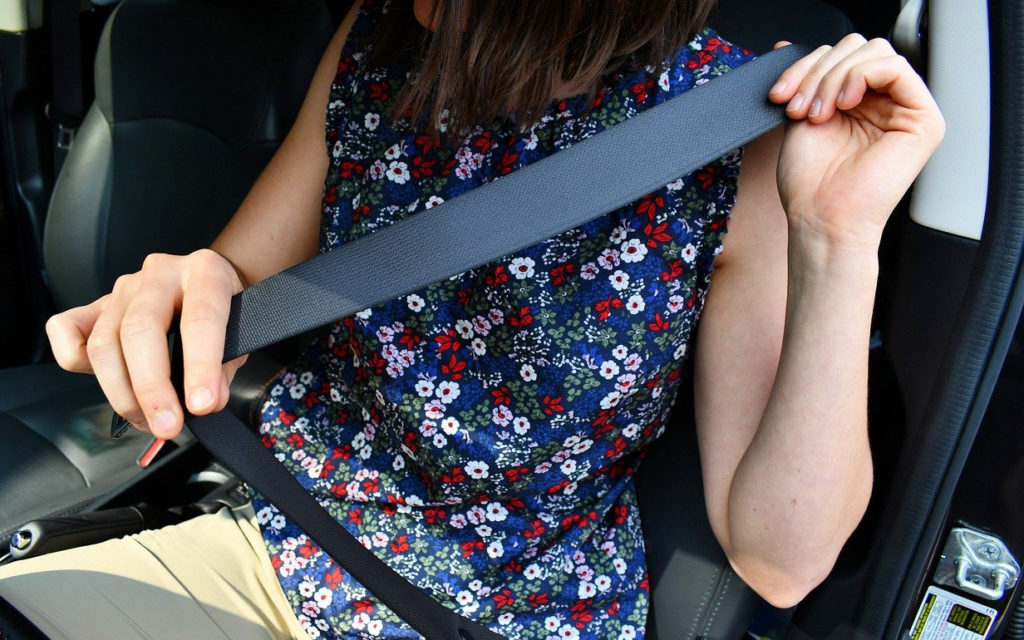
By Jenni Bergal, Stateline
WASHINGTON — When Uber driver Oguzhan Beliren picks up passengers in his Hyundai Sonata, they almost always buckle up in the front seat, and if they don’t, he reminds them to.
But that’s not the case in the rear.
“I’d say that 70 to 80% of my passengers don’t put on a seat belt in the back seat,” Beliren said during a ride on a December evening. “People don’t think they’re required to, and I don’t ask them to do it in back, unless there are kids sitting there or if the weather is bad.”
While most people nowadays make sure children in the rear are in car seats or buckled up, it’s fairly common for adults in back not to wear seat belts, especially when they’re riding in taxis and ride-hailing vehicles such as Uber and Lyft, transportation safety officials say.
The consequences can be deadly.
In Portland, Oregon, for example, a ride-hailing passenger was killed in April when a pickup truck crossed a median and hit the Lexus SUV in which he was riding in the back seat. He was not wearing a seat belt and was ejected through the windshield.
With the explosive growth of ride-hailing in the United States, transportation safety advocates say there needs to be a cultural shift, and passengers should get into the habit of wearing their seat belts in back, just as they do in front.
Safety officials and ride-hailing companies are using social media and marketing campaigns to try to make that happen.
“Ride-sharing has changed this issue of buckling up in back,” said Jonathan Adkins, executive director of the Governors Highway Safety Association, which represents state highway safety offices. “People need to think about it when they get in these vehicles. You need to hear that message, whether on your app or from your driver telling you or by public education campaigns.”
The efforts come in the absence of stronger legislative and federal action.
State legislators have made little headway overall when it comes to rear seat belt laws. This year, legislatures in eight of the 20 states that don’t require rear-seat adult passengers to buckle up considered bills to do so, but only Alabama’s passed.
“It isn’t easy. There’s the libertarian view that, ‘It’s my car; I’m responsible,’” said Jim Hedlund, a governors safety association consultant. “And it’s not high enough on the priority list, and legislatures are busy.”
The National Highway Transportation Safety Administration this fall requested public comments as it decides what kind of warning system to require for rear seat belts, such as lights and dinging sounds, which are mandatory for front seat belts. But the proposal has been in the works for years.
In the meantime, social media campaigns have taken the lead.
‘Changing the Behavior’
Last spring, the governors safety group joined Uber and Volvo in a campaign to remind people to buckle up in back that included blog posts and news releases. Eight states sent out social media messages, Adkins said.
As part of the campaign, during the last two weeks of November, Uber also sent riders in-app seat belt messages that popped up on their phones between the map and their destination. An estimated 10 million riders a week saw the message at least once, said Kristin Smith, an Uber spokeswoman.
“We want to do more than just communicate the importance,” Smith said. “We want to be changing the behavior.”
Adkins said working with a company such as Uber is more effective for states than just sending out their own messaging.
“They have a reach we don’t have,” he said. “They’ve got a gazillion customers and they reach younger people 18 to 35 who we can’t reach.”
While his group hasn’t evaluated the effectiveness of this year’s campaign with Uber, Adkins said it plans to do so when it teams up with the company again in 2020.
One such collaboration wasn’t effective. The North Carolina Governors Highway Safety Program, which represents the Tar Heel State in the governors safety association, joined Lyft last year in a project called Back Seat Buckle Up. The social marketing campaign to encourage seat belt use targeted Lyft customers in Charlotte. Riders who booked a trip during a two-week period and used a special code could get $5 off.
The project “flopped,” according to Mark Ezzell, the North Carolina program’s director. There was no marketing budget, he said, and it had logistical problems and didn’t reach the right people.
“We found that there were zero downloads when the campaign was over,” Ezzell said at a national transportation safety conference in April. Reached by Stateline, Ezzell declined to comment further, other than to say that it was “ultimately unsuccessful due to logistical challenges.”
Lyft said in an email that it encourages all its riders and drivers to buckle up and that Lyft vehicles are required to have a minimum of five functional seat belts, including the driver’s. The company declined to comment on the North Carolina initiative or rear seat belt use in general.
Dangerous Ride
While nearly 90% of drivers and front seat passengers overall in the United States use their seat belts, federal statistics show, that drops to 76% for rear seat adult passengers.
That can be dangerous.
A 2015 study by the Insurance Institute for Highway Safety, a nonprofit research group funded by auto insurance companies, found that unrestrained passengers in the rear were nearly eight times as likely to suffer a serious injury as those who wore seat belts.
“The safety of the back seat relies on people wearing their seat belts,” said Jessica Jermakian, a senior research engineer at the institute. “When people don’t buckle up, they’re not just putting themselves at risk; they’re putting other people in the vehicle at risk because they become a projectile in a crash.”
Last year, 803 unbelted rear seat passengers age 8 and over died in crashes, according to a November report by the governors safety group. More than 400 would have survived had they worn their seat belts.
Transportation safety officials say no national data is kept on injuries or fatalities involving passengers in ride-hailing vehicles or taxis.
But research shows those passengers aren’t buckling up the same as they do in their own cars.
A study of for-hire vehicles in 2017 found that just 28% of taxi passengers in Las Vegas and 26% in San Francisco fastened their seat belts. Eighteen percent did so in ride-hailing vehicles in Las Vegas and 52% in San Francisco.
The researcher who conducted the study, Kenneth Nemire, of HFE Consulting, said it did not evaluate why there were discrepancies in seat belt use between ride-hailing and taxi passengers.
And in a 2017 insurance institute telephone survey, only 57% of passengers who typically travel in taxis and ride-hailing vehicles reported always using their seat belt in the rear.
Taxi and ride-hailing passengers give all sorts of reasons for not buckling up in back.
“They say, ‘It’s a short trip,’ or, ‘I forgot,’ or, ‘There’s no law requiring me to do this,’” said Hedlund, who wrote the November report for the governors safety group. “Or they say, ‘I’m safer in the back seat, so I don’t need to.’”
Little State Action
Nineteen states and the District of Columbia have rear seat belt laws that allow police to stop a car and issue a ticket solely for failure to wear a seat belt.
Eleven other states have secondary enforcement laws for rear seat passengers, which means police can issue a ticket for a seat belt violation only if the driver gets pulled over for another reason. (All states require child safety seats for infants and children fitting specific criteria.)
In the past four years, few state statutes have changed to require rear seat belt use for all passengers. Mississippi was the only state to enact a primary rear seat belt law during that period, and Alabama a secondary law.
“We’re not making much progress with back seat laws,” said Adkins, of the governors safety group. “The map is a little bit depressing.”
On the federal level, Congress instructed the National Highway Transportation Safety Administration in 2012 to start making rules that would require manufacturers to install rear seat belt reminders in passenger vehicles, which may include the lights and beeping sounds that are mandatory when occupants of the front seat are unbuckled.
The agency began working on that task in 2013, but the effort stalled for years. In 2017, two nonprofit traffic safety advocacy groups sued, asking the court to compel the federal agency to comply with the law.
The agency issued a proposal seeking public comment in September. In response, the Alliance of Automobile Manufacturers, a trade group, wrote last month that it supports rear seat belt reminders, which would provide “significant safety benefits.”
The governors safety group and the insurance institute were also among those urging the agency to complete its rule-making and require a rear seat belt warning system.
“Both administrations, Obama’s and Trump’s, have been very slow,” Adkins said. “I think they’re hesitant because many years ago, there was backlash from the public on this for the front seat reminders. People thought they were annoying.”
A spokeswoman for the federal highway safety agency said it does not comment on pending litigation.
Highway safety advocates say regardless of what happens at the federal level, states and for-hire vehicle companies need to put more emphasis on buckling up in back.
Uber and Lyft have policies that urge, but do not require, their drivers to encourage every passenger to wear a seat belt.
“There are states where it’s not required by law,” said Kayla Whaling, an Uber spokeswoman. “That’s why we encourage people, regardless of the law.”
But Uber still has a way to go in getting out that message.
Uber driver Beliren said in the year he has been driving for the company, he doesn’t recall receiving any word about encouraging rear seat passengers to buckle up.
“They never sent me anything,” he said. “But I think it’s a good idea for them to do that.”


